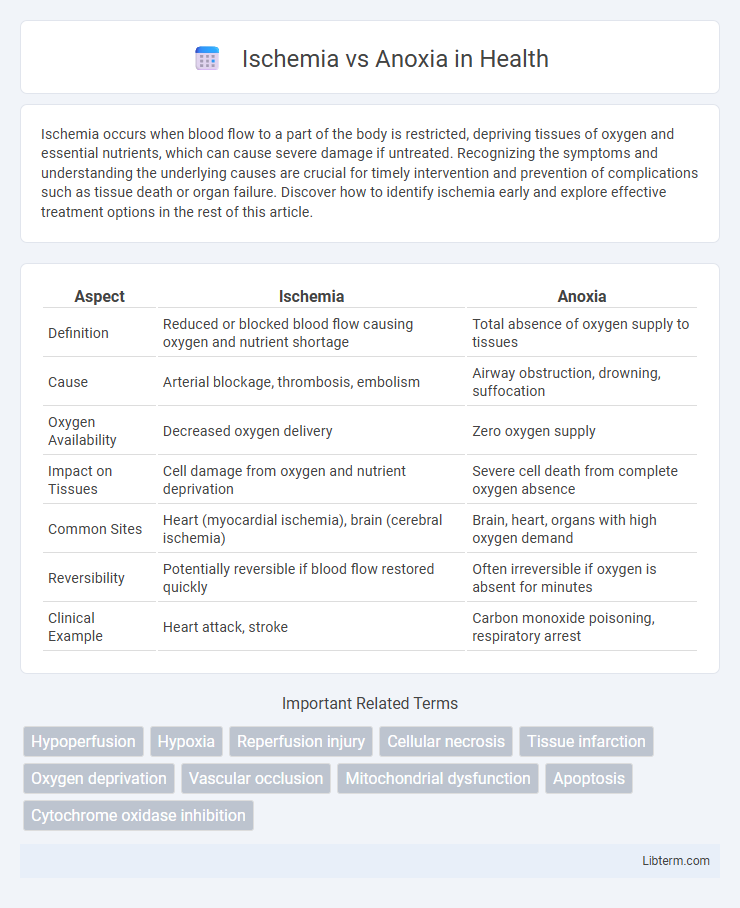Ischemia occurs when blood flow to a part of the body is restricted, depriving tissues of oxygen and essential nutrients, which can cause severe damage if untreated. Recognizing the symptoms and understanding the underlying causes are crucial for timely intervention and prevention of complications such as tissue death or organ failure. Discover how to identify ischemia early and explore effective treatment options in the rest of this article.
Table of Comparison
| Aspect | Ischemia | Anoxia |
|---|---|---|
| Definition | Reduced or blocked blood flow causing oxygen and nutrient shortage | Total absence of oxygen supply to tissues |
| Cause | Arterial blockage, thrombosis, embolism | Airway obstruction, drowning, suffocation |
| Oxygen Availability | Decreased oxygen delivery | Zero oxygen supply |
| Impact on Tissues | Cell damage from oxygen and nutrient deprivation | Severe cell death from complete oxygen absence |
| Common Sites | Heart (myocardial ischemia), brain (cerebral ischemia) | Brain, heart, organs with high oxygen demand |
| Reversibility | Potentially reversible if blood flow restored quickly | Often irreversible if oxygen is absent for minutes |
| Clinical Example | Heart attack, stroke | Carbon monoxide poisoning, respiratory arrest |
Introduction to Ischemia and Anoxia
Ischemia occurs when blood flow to tissues is restricted, causing a deficiency of oxygen and nutrients essential for cellular metabolism. Anoxia refers to the complete absence of oxygen supply to tissues, leading to severe cellular injury and potential tissue death. Both conditions critically impair cellular function but differ in the degree and mechanisms of oxygen deprivation.
Definition of Ischemia
Ischemia is a medical condition characterized by the insufficient blood supply to tissues, resulting in limited oxygen and nutrient delivery essential for cellular metabolism. This deprivation leads to tissue damage and impaired organ function, commonly observed in conditions such as coronary artery disease or stroke. Unlike anoxia, which refers to the complete absence of oxygen, ischemia specifically involves a reduced blood flow that causes partial oxygen deficiency.
Definition of Anoxia
Anoxia refers to the complete absence of oxygen supply to tissues, resulting in a total deprivation that can cause severe cellular damage and organ failure if not promptly addressed. Unlike ischemia, which involves reduced blood flow and consequently diminished oxygen delivery, anoxia specifically denotes an extreme condition where oxygen is entirely unavailable despite blood flow. Understanding anoxia is crucial for diagnosing conditions such as stroke, cardiac arrest, and respiratory failure, where oxygen deprivation plays a central role in pathology.
Key Differences Between Ischemia and Anoxia
Ischemia refers to the reduced blood flow to tissues causing oxygen and nutrient deprivation, while anoxia is the complete absence of oxygen supply to tissues. Key differences include that ischemia involves both oxygen and nutrient deficits due to impaired circulation, whereas anoxia specifically denotes oxygen deficiency regardless of blood flow status. Ischemia often results in tissue damage through combined effects of hypoxia and metabolite buildup, while anoxia primarily causes cellular injury from oxygen deprivation alone.
Causes of Ischemia
Ischemia occurs due to an inadequate blood supply to tissues, caused primarily by arterial obstruction, atherosclerosis, thrombosis, or embolism, which restricts oxygen and nutrient delivery. In contrast, anoxia refers to a complete absence of oxygen in tissues, often resulting from respiratory failure or high-altitude exposure. Understanding ischemia's causes highlights the importance of vascular health in preventing tissue damage and organ dysfunction.
Causes of Anoxia
Anoxia results from a complete lack of oxygen supply to tissues, often caused by severe airway obstruction, suffocation, or carbon monoxide poisoning, which prevents oxygen delivery at the cellular level. Unlike ischemia that involves reduced blood flow and oxygen delivery, anoxia can occur even with adequate blood flow if oxygen content is critically low or absent. These causes lead to rapid cellular damage due to oxygen deprivation, making timely intervention essential to prevent irreversible tissue injury.
Symptoms and Clinical Manifestations
Ischemia presents with symptoms such as localized pain, pallor, and impaired function due to restricted blood flow and oxygen delivery to tissues, often causing muscle weakness and numbness in affected areas. Anoxia, characterized by a complete lack of oxygen supply, leads to severe neurological symptoms including confusion, seizures, loss of consciousness, and in prolonged cases, irreversible brain damage. Both conditions manifest with tissue hypoxia, but ischemia typically causes gradual onset symptoms linked to blood flow obstruction, whereas anoxia results in rapid and widespread cellular dysfunction.
Diagnosis and Medical Evaluation
Ischemia and anoxia are differentiated primarily through diagnostic imaging and blood oxygen level assessments; ischemia is identified by reduced blood flow often confirmed via Doppler ultrasound or angiography, whereas anoxia is diagnosed through arterial blood gas analysis indicating near or total absence of oxygen in tissues. Medical evaluation includes monitoring tissue perfusion, utilizing MRI or CT scans to detect ischemic damage, and employing pulse oximetry to assess oxygen saturation levels critical for diagnosing anoxic conditions. Timely diagnosis relies on correlating clinical symptoms with specific diagnostic markers such as elevated lactate in ischemia or profound hypoxemia in anoxia to guide targeted therapeutic interventions.
Treatment Approaches for Ischemia and Anoxia
Treatment approaches for ischemia prioritize restoring blood flow through thrombolytic therapy, angioplasty, or surgical bypass to prevent tissue damage and improve oxygen delivery. Anoxia treatment focuses on rapidly increasing oxygen supply via supplemental oxygen, hyperbaric oxygen therapy, and addressing the underlying cause of oxygen deprivation. Both conditions require urgent medical intervention to minimize irreversible cellular injury and improve patient outcomes.
Prevention and Prognosis
Ischemia prevention centers on maintaining adequate blood flow through lifestyle changes, managing hypertension, and controlling atherosclerosis to reduce tissue damage risk. Anoxia prevention involves ensuring proper oxygen delivery by addressing respiratory disorders and avoiding high-altitude hypoxia. Prognosis varies; ischemia outcomes improve with timely reperfusion therapy, whereas prolonged anoxia often leads to irreversible cellular injury and poor recovery prospects.
Ischemia Infographic

 libterm.com
libterm.com